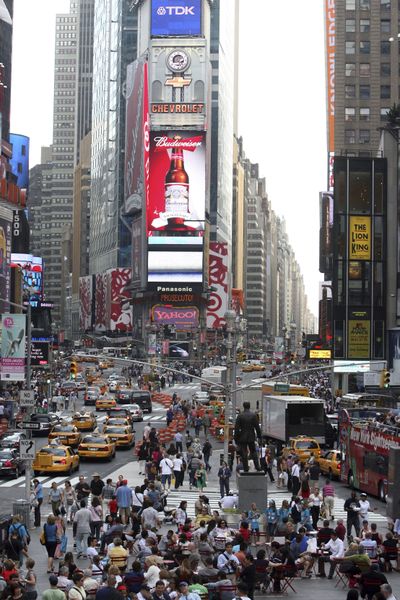Times Square going pedestrian
City officials say banning vehicles will move traffic faster

NEW YORK – Take a walk through Manhattan and it’s clear that pedestrians think they own this city. They dash through red lights on the way to work, meander through traffic-clogged streets and can sometimes bring cars to a standstill with their power in numbers.
Starting today, pedestrians will really own a piece of the city.
Broadway will be closed to vehicle traffic for five blocks at Times Square, turning part of the “Crossroads of the World” into a pedestrian mall of throbbing lights, animated billboards and towering skyscrapers. The city believes the move will reduce pollution, cut down on pedestrian accidents and actually increase the flow of traffic.
A second pedestrian promenade will be created from 33rd to 35th streets on Broadway by Herald Square, where Macy’s dominates the intersection. The city will try out the pedestrian malls for the remainder of the year, and if things go well it could make the change permanent.
Planners hope that the uncontrolled chaos that has long defined the heart of this city will shift to a gentler landscape, one where a visitor could conceivably use the word “stroll” to describe getting from one side of Times Square to the other.
No one’s strolling there now. Crowds press up against each other, body to body, pushing the unlucky onto the street to walk alongside the cars. A sea of yellow cabs trickles foot-by-foot down Broadway.
With 350,000 people walking through Times Square every day, and many stepping onto the asphalt road to edge around the human traffic jams, injuries here are 140 percent higher than in nearby areas, says city Transportation Commissioner Janette Sadik-Khan, who compares walking through the crowds to “a human slalom course.”
New York does have a history that has added to its traffic woes, Sadik-Khan says.
In 1811, traffic commissioners developed the grid system that would define the city’s streets, but they left in place a precolonial footpath cutting diagonally across Manhattan. Broadway’s irregular path created a number of the squares that define city life – from Union Square to Times Square. But it also jammed up the flow of vehicle traffic, creating three-way intersections at hot spots throughout the city.
“It contradicts the order of the city’s grid,” Sadik-Khan says. “We’re really trying to knit the city back together and fix something that’s been broken for 200 years.”
With cars no longer cutting diagonally across the grid, planners believe traffic will actually move 17 percent faster. Cars will still be allowed to cut across the new pedestrian promenade at cross streets, but they will then be rerouted to a newly widened Seventh Avenue and other north-south avenues across the grid.
From 42nd Street to 47th Street, planners hope pedestrians will lounge at outdoor seating and stroll along the avenue. They hope drivers will begin using Broadway between the two promenades only if they’re headed right there.
As construction on the project continues throughout the summer, the city has hired an array of musicians, magicians and other performers to keep lunchtime crowds in the area. Next month, they will broadcast the Tony Awards on the new Broadway promenade. And in December, the Transportation Department will complete a report meant to help decide whether the setup should be permanent.